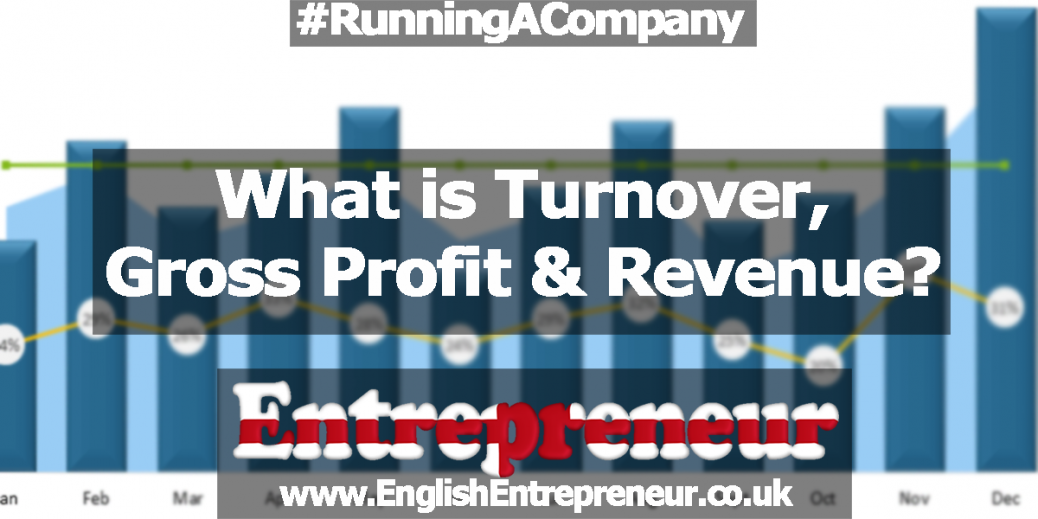There are many things to learn if you are new to starting a company and much of it can feel very daunting.
Any fan of Dragon’s den will be quick to tell you how you must ‘know your numbers’ along with a ton of other advice based on current UK entrepreneur’s mistakes.
Unfortunately it is not possible to categorise one subject to be the most important thing to know when running a company or business. If it were then the question of turnover, gross profit and net profit would have a strong bid to being that holy grail.
Any successful business is constantly checking all three of these KPI’s (key performance indicators) on a weekly basis since the goal of most businesses is to make money.
Money coming in and going out is the be all and end all at the very heart of every business plan, at least every successful one!
In this article we go over in plain English what exactly is revenue, turnover and profit while running a business.
Whether you have a new company or an existing one then we hope we can shed some light on these misunderstood topics.
What Is Turnover?
Turnover in business is essentially going to be your top level number when going through your company finances.
Turnover in the UK is what our cousins in USA call revenue. It is the total amount of money that has come into your business through the sale of services or products.
Every penny that comes into your business will tally towards your company’s overall turnover for that given period.
An Example Of Turnover
John owns a vitamins company that he hosts exclusively in an online eCommerce website.
John’s eCommerce website has made sales to the tune of £12,430 in the last financial year.
John’s turnover, or revenue if you prefer, for this year will be £12,430.
What Is Gross Profit?
Gross profit is the next step down in your company financials representing you turnover minus your cost of goods sold.
Gross profit is essentially your halfway house between your top line, turnover, and your bottom line of net profit.
If your company is selling some sort of product then your cost of goods sold will be a sum of:
- All costs involved in manufacturing the item
- Any cost related to packaging the item
- The cost of delivering or shipping the item
If your company is selling a service based product then your cost of goods will include the sum of:
- Labour costs in delivering the service
- Materials used in providing the service
- Any transportation costs related to the service
Gross profit is useful to work out your sales margins and to see exactly how much you make per item or service sold.
An Example Of Gross Profit
Sticking with John who owns a vitamins company that he hosts exclusively in an online eCommerce website.
Johns turnover mentioned above is £12,430 in the last financial year. As we have learned this means John has sold £12,430 worth of vitamins.
John’s total cost of making those vitamins is £1000, packaging them £500 and delivering them to the customer is £250.
This brings the total cost of goods sold, i.e. the total cost to make and get the vitamins to the buyer, £1750.
Based on this John’s gross profit is £10,680 (£12,430 – £1750 or turnover minus costs of good sold (COGS).
What Is Net Profit?
Our final step down the company financials ladder is going to be our bottom line, net profit.
In terms of importance, net profit is probably THE most important of these three metrics. Net profit represents how much profit is left after every expense of your business has been paid.
To work out your net profit you need to be subtracting from your gross profit any and all of the following:
- Rent
- Website costs / office running costs
- Credit card handling and transaction fees
- Utilities
- Employee wages
- Taxes
- Loans
The number you are left with here is clear profit! Whether this is reinvested or paid out to employees is your call but after everything is said and done, this is the number for your net profit line.
An Example Of Net Profit
John and his eCommerce website have established a turnover of £12,430 and a gross profit of £10,680.
John now calculates website hosting fee of £150, merchant card handling fees of £250, £400 in taxes and wages of £9,000 over the financial period.
Johns net profit is £880 (£10,680 – £150 – £250 – £400 – £9000).
John may now pay himself a bonus or reinvest in adverts for the next financial year but for this period his net profit is now calculated
Conclusion
Knowing the difference between Turnover, Gross profit and net profit is a fundamental part of running a company in the UK.
Any business owner, new or experienced, are fundamentally required to know these metrics wherever possible.
Not knowing these numbers could be a strong indication that you don’t in fact understand your own business correctly. Your business may not be as profitable as you think and you may be missing easy areas you could improve.
Knowing all this it is understandable why the Dragons on Dragon’s den react the way they do when presented with an unprepared entrepreneur.
Knowing these numbers shows you know your company and the business it produces.


